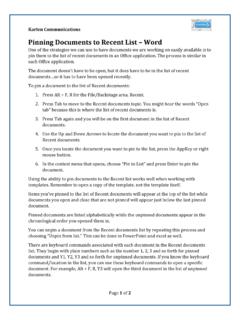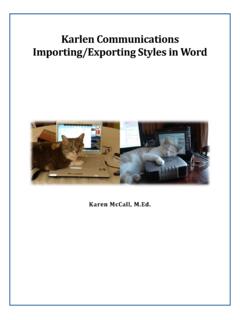Transcription of Office 2013 Settings and Changes
1 Karlen Communications Office 2013 Settings and Changes By Karen McCall, 2 This document copyright 2013 by Karen McCall. Karen is a Microsoft Word MVP (2009- 2013 ). Contact: 3 Table of Contents Signing Into Office .. 4 Settings to Make Word Easier to Use .. 5 change the Application Colour Theme .. 5 Turn Off the Start Screen .. 7 Turn off Click and Type .. 8 Turn off Reading View .. 9 Protected View of Documents .. 10 Clearing Formatting .. 10 Copy and Paste Options .. 11 Putting a Tool on the Quick Access Toolbar .. 13 Office 2013 File Format and Fonts .. 14 Design Ribbon in Word .. 16 The Office Sounds .. 17 Changes from Office 2003, 2007 and 2010 .. 17 Open Documents .. 17 Pin a Document to the Recent Documents List .. 18 Save Documents .. 19 Use a Template/New Document .. 20 Spell Check .. 21 Finding words or Phrases .. 23 Adding Alt Text to Images .. 25 New Features that are Useful.
2 26 Resume Reading .. 26 PDF 27 Online Presentation .. 28 PowerPoint Slide Size .. 32 4 Signing Into Office The first change you ll notice is that you now have to sign into Office when you first launch any Office application. Once you sign in, you can remain signed in and don t have to do this again. If you have a word account and a home account, or if family members have access to different documents than you, you can sign out of Office when finished working and the next person to use the computer will need to sign into Office to work with it. Figure 1 File/Backstage area where you can see account information This provides some flexibility and lets you use a single sign in for Office to synchronize your Office Settings across computers. For example if you use the same sign in for Office on your desktop as your laptop, you will be working in the same Office space. Your colour Theme will be the same on both devices (for example) and you will have access to the same integration with SkyDrive (cloud storage).
3 You can use the same sign in information for Office as you did for Windows 8. However, you will have to sign into Windows and Office separately. To switch users once someone is signed in: 1. Press Alt + F, D S for File Backstage area, Account, Switch User 2. When the dialog opens, type in the username and password you want. 3. Tab to the Sign In button and press Enter. That s it, you ve switched user accounts for Office on this device. The other options under Account let you: Press C to change Picture. This is the picture or icon used for your account. Press M for About Me to access or modify profile information. Press E to Sign Out of Office . 5 Settings to Make Word Easier to Use Before you begin working with Office 2013 and specifically Word 2013 , there are some Settings you may want to consider changing in order to work with the applications more effectively if you are using adaptive technology or the keyboard.
4 The following are a few I ve found useful in changing. After the section on Settings you might want to change I ve added a section on some of the Changes to the way we work with Office 2013 such as the spell check now being in a pane to the right of the document rather than in a traditional dialog and the Changes to Open, new and Save As in all Office 2013 Applications. change the Application Colour Theme One of the most complained about Changes in the Office 2013 look and feel is the fishbowl or the overall user-interface. There is not enough contrast between the document, the surrounding fishbowl and the Ribbons. Everything tends to blur into each other. This is compounded by the default setting of white which is blinding if you don t already have a visual disability. There are complaints about this from people with and without disabilities who are now finding it quite fatiguing to work with documents over long periods of time.
5 There are three colour themes for Office 2013 applications. They are white, light gray, or dark grey. This is a setting that is easy to change so try all three to find the best one for you. If you are using the Ease of Use or Accessibility Options themes such as High Contrast Black the High Contrast Theme will be used in Office 2013 applications. You don t need to worry about the Office Themes. If you do choose one of the Office Themes such as white, light gray or dark gray, the theme you choose will be used in all Office applications. Figure 2 White Theme and File/Backstage area. 6 To change the Office 2013application colour theme: 1. Press Alt + F, D, Y, number 1 to open the File/Backstage area, Office Account tab, and put focus in the Office Themes list box. 2. Use the Up and Down Arrows to choose your Office Theme. 3. Press Enter on the Office Theme you want and then press Escape to get back to your document.
6 You should notice the change immediately. This change will take effect for all Office applications. Figure 3 Light Grey Theme and File/Backstage area. The Light Grey Theme provides some contrast, the Dark Grey Theme results in a better contrast between the document and the rest of the application and has the File/Backstage area Black with Blue highlight for the tool in focus. Figure 4 Dark Grey Theme and File/Backstage area. 7 You can also change the Office Theme by going into the Word Options (PowerPoint Options, Excel Options and so forth) by pressing Alt + F, T which takes you to the File/Backstage area, Word Options and opens the Word Options dialog. Press Alt + T for Office Themes. This moves you to and opens the list of possible Office Theme colours. Once you ve made your choice, Tab to and activate the OK button by pressing Enter. Turn Off the Start Screen Office 2013 applications now launch with a Start Screen which is a list of recent documents and possible templates for documents.
7 If you prefer the cleaner look and feel of a blank new document, you can turn off the Start Screen. Figure 5 Start Screen in Word To turn off the Office Start Screen in any Office 2013 application: 1. Press Alt + F, T for the File/Backstage area, Word Options. 2. When the Word Options dialog opens, focus should be on the General category which is the first category of Settings . 3. Press Alt + S to move to and uncheck the check box to Show the Start Screen on Start-up. 4. Tab to and activate the OK button by pressing Enter. Figure 6 Check box to turn off Start Screen in Word 2013 . 8 The gallery of templates isn t really useful unless you are creating lots of decorative inclusive documents Although you can choose from the list of your personal templates, you can also do this by pressing Alt + F, N for File/Backstage area, New. Most of us just like to start with a new blank document and then get the document we are working on.
8 Again, this can be accomplished by pressing Alt + F, R for File/Backstage area, Recent/Open Document. This is a personal preference so try using the Office 2013 applications with and without the Start Screen to decide whether it is useful for you or not. Turn off Click and Type Click and Type which is a Word setting, lets you click anywhere on the page and begin typing. The implications for anyone using adaptive technology is that you could inadvertently activate the left mouse button and begin typing thinking you are at the margin when in reality you could be anywhere on the line or on the page. Figure 7 Click and Type option unchecked (last item in image). To turn off Click and Type in Word: 1. Press Alt + F, T to open the File/Backstage area, Word Options dialog. 2. Use the Down Arrow to move to the Advanced options or press the letter A. 3. Press Tab to move into the Advanced Options. 4. Press the letter C to move to the checkbox to enable click and type.
9 There is more than one item that uses the letter C to get to it, so listen to your adaptive technology carefully, and watch where your focus is. 5. Use the Spacebar to uncheck this checkbox. 9 6. Move to and activate the OK button by pressing Enter or clicking on it with the mouse. Turn off Reading View Reading View (the old Reading Layout or Full Screen Reading Layout) is still not accessible if you are using either Text-to-Speech or screen reading. If a document opens in Reading View you will get a message saying that this is an inaccessible way of viewing documents and you will have to look around to find the Edit button and return to normal document view. If you have a learning or visual disability and are using a tablet, Reading View (without speech support) might be a useful tool as it now incorporates gestures and lets you basically reflow your Word document on a tablet and resize the view of the with gestures.
10 Reading View is the default way of viewing documents that you will receive through e-mail. I suggest turning this option off in order to minimize frustration. Figure 8 Check box to turn off Reading view for e-mail attachments. To turn off documents opening in Reading View: 1. Press Alt + F, T to open the File/Backstage area, Word Options dialog. 2. Move to the General options. They should be the first set of options in the list. 3. Press Alt + letter O to move to and uncheck the option to Open e-mail and other uneditable files in reading view. 4. This will also affect any documents set by the document author to open using this view. 5. Move to and activate the OK button to confirm your choice and exit the Word Options dialog. Documents will now open normally in Word. You can always switch to Reading View in Word by going to the View Ribbon and choosing it if you have a tablet. 10 Protected View of Documents In the previous topic of Reading View we found the words or uneditable files in the Reading View setting.






